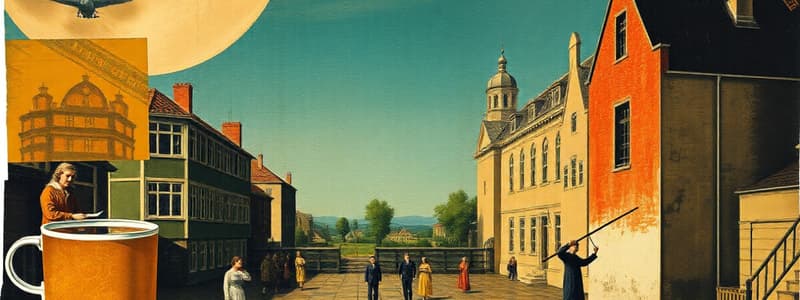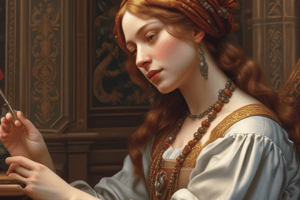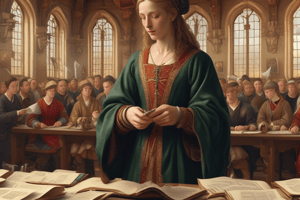Podcast
Questions and Answers
What distinguishes Early Netherlandish painting from later styles?
What distinguishes Early Netherlandish painting from later styles?
- Attention to detail and rich colors (correct)
- Preference for watercolors over oil paints
- Focus on individual artist creativity
- Use of wide-angle perspectives exclusively
Which vocabulary term describes the technique that creates a strong contrast between light and shadow?
Which vocabulary term describes the technique that creates a strong contrast between light and shadow?
- Chiaroscuro (correct)
- Trompe l’œil
- Noodnaam
- Impasto
Which artist is recognized for revolutionizing oil painting techniques during the Early Netherlandish period?
Which artist is recognized for revolutionizing oil painting techniques during the Early Netherlandish period?
- Jan van Eyck (correct)
- Jacob de Gheyn II
- Pieter Coecke van Aelst
- Vincent Van Gogh
What is the meaning of the term 'Noodnaam' in the context of art?
What is the meaning of the term 'Noodnaam' in the context of art?
Which of the following describes the 'impasto' technique in painting?
Which of the following describes the 'impasto' technique in painting?
What aspect of Rogier van der Weyden's works is emphasized in the description?
What aspect of Rogier van der Weyden's works is emphasized in the description?
Which painting primarily served as a devotional tool to experience the suffering of Christ?
Which painting primarily served as a devotional tool to experience the suffering of Christ?
What characteristics define the portraits created around 1430?
What characteristics define the portraits created around 1430?
What common theme is present in the works of Hieronymous Bosch?
What common theme is present in the works of Hieronymous Bosch?
Which of the following best describes the influence of the printing press during the Northern Renaissance?
Which of the following best describes the influence of the printing press during the Northern Renaissance?
What is characteristic of Bruegel's later paintings compared to his earlier works?
What is characteristic of Bruegel's later paintings compared to his earlier works?
What was a significant outcome of the Eighty Years War from 1568-1648 for the art market?
What was a significant outcome of the Eighty Years War from 1568-1648 for the art market?
Which element was common in the altarpieces during the Northern Renaissance?
Which element was common in the altarpieces during the Northern Renaissance?
Which statement accurately describes the 'Kunstkamer'?
Which statement accurately describes the 'Kunstkamer'?
What moral lesson is illustrated in the 'The Garden of Earthly Delights'?
What moral lesson is illustrated in the 'The Garden of Earthly Delights'?
What characteristic defines the 'Fine Manner' of painting?
What characteristic defines the 'Fine Manner' of painting?
Which school of painting in Holland was known for dramatic chiaroscuro and theatrical elements?
Which school of painting in Holland was known for dramatic chiaroscuro and theatrical elements?
What was a significant outcome of the Commercial Point of View in art production?
What was a significant outcome of the Commercial Point of View in art production?
Which artist is famous for their highly detailed portrayal of light in paintings?
Which artist is famous for their highly detailed portrayal of light in paintings?
What type of painting did Frans Hals commonly create?
What type of painting did Frans Hals commonly create?
What did the term 'Tulipmania' refer to in the context of Dutch art and economy?
What did the term 'Tulipmania' refer to in the context of Dutch art and economy?
Which painting style is associated with Pieter Mondriaan?
Which painting style is associated with Pieter Mondriaan?
What is a primary feature of the paintings from the Delft school of art?
What is a primary feature of the paintings from the Delft school of art?
Which of the following genres did Johannes Vermeer NOT primarily focus on?
Which of the following genres did Johannes Vermeer NOT primarily focus on?
What characterized the shoulder pieces in 17th-century portrait painting?
What characterized the shoulder pieces in 17th-century portrait painting?
Which artist had a significant influence on Vincent van Gogh during his career?
Which artist had a significant influence on Vincent van Gogh during his career?
What was a common characteristic of women artists like Clara Peters and Judith Leyster in the 17th century?
What was a common characteristic of women artists like Clara Peters and Judith Leyster in the 17th century?
Which aspect was NOT a primary focus for genre painting in the 17th century?
Which aspect was NOT a primary focus for genre painting in the 17th century?
Flashcards
Early Netherlandish Painting
Early Netherlandish Painting
A style of painting that emerged in the Netherlands before 1550. It was characterized by the use of oil paint, detailed depictions, rich colors, and a lifelike quality.
Verisimilitude
Verisimilitude
The quality of appearing true to life or reality. It's a key feature of Early Netherlandish art.
Homo Universalis
Homo Universalis
A person with a wide range of knowledge and skills, often considered an expert in many fields. This concept was relevant to Renaissance artists.
Trompe l’œil
Trompe l’œil
Signup and view all the flashcards
Jan van Eyck
Jan van Eyck
Signup and view all the flashcards
Devotional Pictures
Devotional Pictures
Signup and view all the flashcards
Devotio Moderna
Devotio Moderna
Signup and view all the flashcards
Altarpieces
Altarpieces
Signup and view all the flashcards
Triptych
Triptych
Signup and view all the flashcards
Portrait Paintings (around 1430)
Portrait Paintings (around 1430)
Signup and view all the flashcards
Hieronymous Bosch
Hieronymous Bosch
Signup and view all the flashcards
The Garden of Earthly Delights
The Garden of Earthly Delights
Signup and view all the flashcards
Northern Renaissance
Northern Renaissance
Signup and view all the flashcards
Albrecht Durer (1471-1528)
Albrecht Durer (1471-1528)
Signup and view all the flashcards
Bruegel
Bruegel
Signup and view all the flashcards
Fine Manner
Fine Manner
Signup and view all the flashcards
Broad Manner
Broad Manner
Signup and view all the flashcards
Haarlem School
Haarlem School
Signup and view all the flashcards
Utrecht Caravaggists
Utrecht Caravaggists
Signup and view all the flashcards
Amsterdam School
Amsterdam School
Signup and view all the flashcards
Leiden School
Leiden School
Signup and view all the flashcards
Delft School
Delft School
Signup and view all the flashcards
Tulipmania
Tulipmania
Signup and view all the flashcards
Influence of Antwerp
Influence of Antwerp
Signup and view all the flashcards
Types of Portraits
Types of Portraits
Signup and view all the flashcards
Purpose of Portraits
Purpose of Portraits
Signup and view all the flashcards
Frans Hals' Portrait Style
Frans Hals' Portrait Style
Signup and view all the flashcards
Rembrandt's Artistic Development
Rembrandt's Artistic Development
Signup and view all the flashcards
Johannes Vermeer's Style
Johannes Vermeer's Style
Signup and view all the flashcards
Vincent van Gogh's Inspiration
Vincent van Gogh's Inspiration
Signup and view all the flashcards
Study Notes
Early Netherlandish Painting (Before 1550)
- Focused on painted altarpieces, primarily in the Burgundian Lands (1369–1482).
- Bruges was a major international port, driving wealth through cloth manufacture and trade.
- Artists were artisans, with limited individual creative freedom.
- Key characteristics included the use of oil paint, technical skill in perspective and detail, rich colors, and verisimilitude (lifelikeness) in portrayal of textures.
Dutch and Flemish Painting (After 1550)
- Dutch art developed after 1550 in the Northern Netherlands.
- Flemish art developed after 1550 in the Southern Netherlands.
- Artists' identities were sometimes lost, leading to the use of invented names (e.g., Master of Flémalle).
- "Homo Universalis" refers to artists with broad skill sets (e.g., painting, sculpting, anatomy, architecture, languages).
- Techniques, like chiaroscuro (light/shadow contrasts) and trompe l'oeil (realistic illusionism), emerged.
Northern Renaissance Painting
- The invention of the printing press facilitated information spread.
- Antwerp became the cultural and economic center of the Low Countries, replacing Bruges.
- Specialized painting genres developed, including devotional art, portraits, altarpieces, and genre painting.
- Significant artists like Jan van Eyck, Rogier van der Weyden, and Hieronymous Bosch shaped Northern Renaissance style.
- Bosch's work often depicted scenes of daily life, but with moralizing and symbolic elements reflecting aspects of human nature and the struggle for salvation.
- Bruegel (and his sons) continued in this tradition, exploring themes of peasants, festivals, and landscapes, with a shift towards monumental figures and balanced compositions.
- Durer from southern Germany introduced motifs and nudes, signed his works, and used Latin labels.
Functions of Netherlandish Paintings
- Devotional pictures were crucial in the Devotio Moderna movement, promoting meditation and visualizations of religious figures.
- Altarpieces were popular, serving as focal points for Catholic Mass, often in various formats and materials.
- Portraits emerged around 1430, portraying patrons and individuals, emphasizing lifelikeness using oil paint and 3/4 views.
17th-Century Dutch Painting
- The art market in the Netherlands was diverse. Patrons were extensive (government, charity, and guild groups).
- Genre painting explored scenes of everyday life, with various styles.
- Painters like Hals, Rembrandt, and Vermeer developed distinctive artistic styles and influenced future artists.
- Vermeer mastered techniques with light and color, often portraying women.
- Hals and Rembrandt focused on natural poses, capturing the moment. Hals often displayed wealth through attire.
- "Broad Manner" involved visible brushwork, whereas "Fine Manner," showed smooth, finished look often more expensive
- Schools in different Dutch cities developed distinct styles.
- Still life painting was a significant genre, showing the Dutch economy's wealth and prosperity.
19th and 20th-Century Painting
- Romanticism drew inspiration from 17th-century landscape styles, placing emphasis on mood and atmosphere rather than strict realism.
- Van Gogh shifted towards more expressive, emotional styles influenced by Japanese art, and bold colors.
- Impressionist techniques, and pointillism were applied.
- Mondrian pioneered abstract art, influenced by 17th-century artwork developing his Non-objective Neoplastic style.
- Women artists, like Clara Peters and Judith Leyster, were also significant in this movement and challenged societal expectations.
Historical Events
- Important historical events, such as the Protestant Reformation, the Iconoclastic Fury, and the Eighty Years' War, influenced artistic production throughout this period.
- Iconoclasm, political unrest, and economic change impacted subject matter and patronage.
Other Important Info
- "Kunstkamer": art cabinets with collections, unique to the Southern Netherlands, became important.
- Influenced by Antwerp, including notable artists like Rubens, van Dyck, Jordeans, Hals, Rembrandt, and Vermeer.
- Artists often collaborated or had mutual influences.
- Dutch painting markets fostered a wide range of types of painting, affordable to many.
- Many important artists specialized in diverse categories of artwork.
Studying That Suits You
Use AI to generate personalized quizzes and flashcards to suit your learning preferences.




